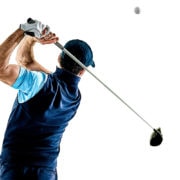How to Recognize and Treat Overuse Injuries

Maybe you’re active but not a “real athlete,” so you think you’re immune to overuse injuries. Think again. Anyone who’s active is prone to the nagging injuries that come with repetitive motions or misalignment in the body. “An athlete can be a recreational runner, swimmer, or golfer,” said Andy Patterson, physical therapist for BenchMark Physical Therapy. “They’re all athletes.” Among recreational athletes, overuse injuries are more common than acute injuries, such as broken bones and torn ligaments. Overuse injuries can hamper mobility and cause pain. They can strike at any age. They are preventable and they are treatable, so active people can stay in the game.
What is an overuse injury?
You’ve probably heard of tennis elbow, Little Leaguer’s elbow, shin splints, or plantar fasciitis. All are overuse injuries, and there are many others. The underlying cause is the “cumulative or repetitive microtrauma” endured time and again by a single part of the body, said Patterson. Damage accrues to bones, muscles, ligaments, or tendons. Tissue becomes inflamed, and the area degenerates.
Causes of overuse injuries:
• Repetitive motion
• Overtraining
• Sudden bursts in activity
• Built-in risk factors such as misalignment, muscle imbalances, muscle weakness, and joint instability
 Avoiding overuse injuries
Avoiding overuse injuries
To prevent overuse injuries, remember the fundamentals of staying active:
• Warm up properly: Start at lower intensity and “give the heart and tissues time to adapt to what you’re doing,” said Patterson. Today’s warmups are dynamic, not stretching cold muscles but gentle movements that activate muscles and nudge up the heart rate.
• Cool down: “An active cooldown with stretching or myofascial mobility – using a foam roller over the areas that may be contributing to your pain –can be very bene cial,” Patterson said.
• Vary activities: Because repetitive motion is a frequent culprit, adding a new sport gives overburdened muscles and joints time to rest. This is especially important for children and teens, when “the bones are getting big and the muscles are playing catchup,” said Patterson.
Treating overuse injuries
If you suspect an overuse injury, have a doctor check for weakness, flexibility, and imbalances. “The body is influenced by everything around it,” said Patterson. “If I have foot pain, it may be local to that area, or it could be coming from higher up in the chain.”
Once the problem area is diagnosed, a physical therapist or athletic trainer specializing in the condition can recommend a course of treatment. Typical elements include:
• Resting the inflamed area: Rest doesn’t always mean no activity. A physical therapist might recommend modified activity, known as “active rest,” when the injured area is idle but the whole body doesn’t decondition entirely.
• Strengthening regimen: Stronger muscles in the shoulders or core, for instance, can support movement throughout the body.
• Progressive return: Just because the injured area is healed doesn’t mean it’s ready to perform at 100 percent. The physical therapist can reevaluate the body and suggest a gradual restorative plan, perhaps with modifications to prevent recurrence.
The physical therapists of BenchMark Physical Therapy are highly trained, dedicated, and ready to help athletes of all types get back to their active lifestyles.
 BenchMark Physical Therapy is a family of physical therapists, occupational therapists, and hand therapists committed to inspiring and empowering people to reach their full potential. Its providers know that connecting with patients on a personal level helps to build trust. This trust is crucial in allowing patients and therapists to work together to make the best use of advanced certifications and re ned techniques. A focus on proven methods and a hands-on approach help the BenchMark team achieve the goals of the patient in a safe and effective manner.
BenchMark Physical Therapy is a family of physical therapists, occupational therapists, and hand therapists committed to inspiring and empowering people to reach their full potential. Its providers know that connecting with patients on a personal level helps to build trust. This trust is crucial in allowing patients and therapists to work together to make the best use of advanced certifications and re ned techniques. A focus on proven methods and a hands-on approach help the BenchMark team achieve the goals of the patient in a safe and effective manner.



